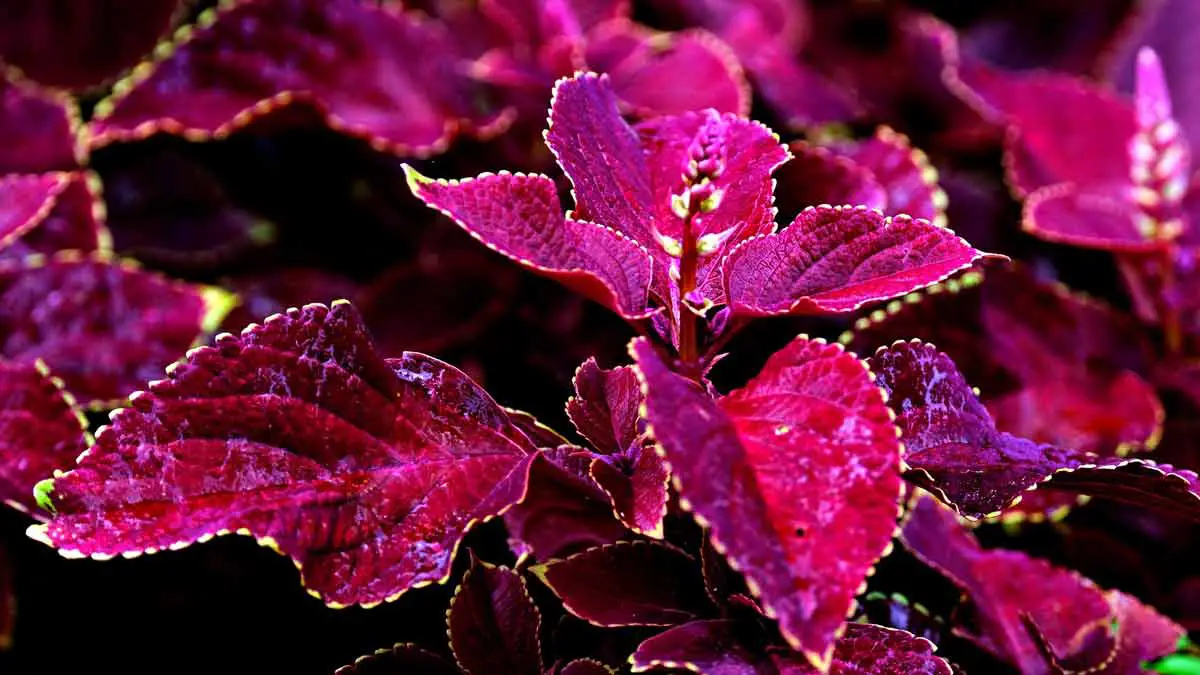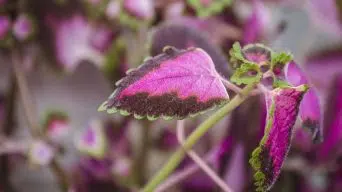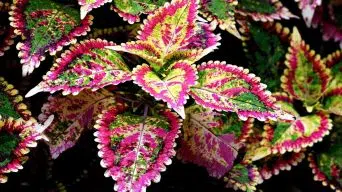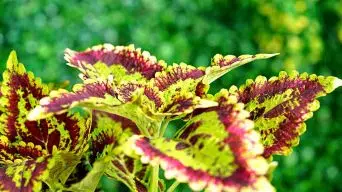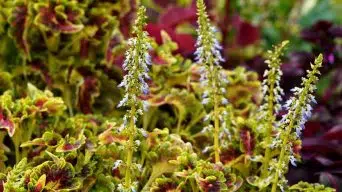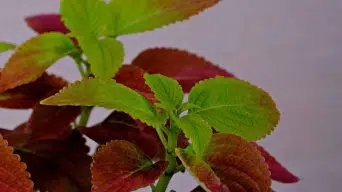Coleus plants are known for their colorful foliage, which can add a touch of brightness to any garden.
However, if you notice your coleus leaves curling, it may be a sign that something is wrong.
Several potential reasons for this problem include pests, watering issues, and environmental stress.
Fortunately, a few simple solutions can help correct the issue.
Here you will find an overview of the most common causes of coleus leaves curling and some helpful tips on how to fix the problem.
Why Are My Coleus Leaves Curling and How Can You Fix It?
Curling leaves on a coleus plant can be caused by several different problems. It’s essential to identify the source of the issue so that you can take the appropriate steps to fix it.
Here are ten of the most common reasons for coleus leaves curling, along with some tips on how to solve the problem.
1. Underwatering
One of the most common causes of coleus leaves curling is underwatering. If your plant doesn’t get enough water, the leaves will begin to curl and droop in an effort to conserve moisture.
Underwatering can result from infrequent watering or simply not giving your plant enough water when you do water it.
How To Tell If Your Plant Is Underwatered
There are a few tell-tale signs that your plant is not getting enough water, including:
- The leaves are drooping
- The leaves are turning yellow or brown
- The leaves are dry or papery
- The plant is wilting overall
- The soil is dry to the touch
How To Treat an Underwatered Coleus Plant
If you think your plant is not getting enough water, the first step is to check the soil. If it feels dry to the touch, give your plant a good watering.
Be sure to water slowly and deeply so that the water has a chance to reach the roots. Once the soil is evenly moistened, allow it to drain before returning the plant to its pot.
It’s also a good idea to water your plants in the morning, so they have all day to dry out before nightfall. This will help prevent problems such as fungal growth.
2. Overwatering
While underwatering is one of the most common causes of coleus leaves curling, overwatering can also be a problem.
If your plant gets too much water, the leaves will begin to curl and yellow due to oxygen deprivation. The roots may also start to rot, which can kill the plant.
How To Tell If Your Plant Is Overwatered
There are a few signs that you may be overwatering your coleus, including:
- The leaves are yellowing or wilting
- The leaves are limp
- The stems are soft
- There is mold or mildew on the leaves
- The plant is dropping leaves
- The soil is always soggy
How To Treat an Overwatered Coleus Plant
If you think your plant is getting too much water, the first step is to check the soil. If it feels soggy or wet, allow it to drain before watering again.
Letting the soil dry out completely between waterings is also a good idea. This will help prevent overwatering in the future.
If the roots of your plant are already rotting, you may need to repot it in fresh, dry soil. Be sure to remove any dead or damaged roots before replanting.
3. Pests
Pests can also be a common cause of coleus leaves curling. Aphids, mealybugs, and spider mites are all common pests that can attack coleus plants.
These pests can cause the leaves to curl and yellow as they feed on the plant. They can also spread disease, which can further damage your plant.
Aphids are small, soft-bodied insects of various colors, including green, black, and brown. They tend to congregate on the undersides of leaves and stems, feeding on the plant’s sap.
Mealybugs are small, wingless insects covered in a white, powdery substance. They feed on the plant’s sap, which can cause the leaves to yellow and curl.
Spider mites are tiny, eight-legged pests that are difficult to see with the naked eye. They spin webs on the undersides of leaves, where they feed on the plant’s sap.
How To Tell If Your Plant Has Pests
There are a few signs that your plant may have pests, including:
- The leaves are yellowing or curling
- The leaves are covered in webbing
- The plant is being eaten
- There are small insects on the plant
How To Treat a Plant With Pests
If you think your plant has pests, the first step is to isolate it from any other plants. This will help prevent the pests from spreading.
Next, you need to remove the pests from the plant. You can do this by hand or use a natural pest control method, such as neem oil.
You can use a cotton swab dipped in rubbing alcohol to remove them by hand. Dab the pests with the cotton swab to kill them.
You can make a neem oil spray if you prefer a natural pest control method. To do this, mix 1 teaspoon of neem oil with 1 cup of water.
Spray the mixture on the plant, being sure to cover all of the affected areas. You must reapply the spray every few days until the pests are gone.
4. Too Much Light
While coleus plants thrive in bright indirect light, too much light can cause the leaves to curl.
If the leaves are exposed to direct sunlight, they can sunburn. This will cause the coleus leaves to turn brown or yellow and eventually curl up.
A sunburned leaf will have a leathery texture and feel dry to the touch.
How To Tell If Your Plant Is Getting Too Much Light
There are a few signs that your plant is getting too much light, including:
- The leaves are yellowing
- The leaves are wilting
- The leaves are drying out
- The leaves are curling
- The leaves have brown spots
How To Treat a Plant That Is Getting Too Much Light
If you think your plant is getting too much light, the first step is to move it to a shady spot.
When grown indoors, you can place your plant in an east- or west-facing window. This will ensure it gets bright indirect light without being exposed to direct sunlight.
You can also try using a sheer curtain to filter the light if you can’t move the plant.
You can place your plant outdoors in the shade of a tree or other structure. Just be sure the plant isn’t receiving direct sunlight, especially during the hottest hours of the day.
5. Too Much Fertilizer
Fertilizing your coleus plant is essential to promote healthy growth. However, too much fertilizer can damage the plant.
When a plant is overfertilized, the roots can’t absorb all nutrients. This can cause a build-up of chemicals in the soil, damaging the roots and leaves.
An overfertilized plant will have yellow or brown leaves wilting, curling, and falling off. The plant may also stop growing.
How To Tell If Your Plant Is Overfertilized
There are a few signs that your plant is overfertilized, including:
- The leaves are yellow or brown
- The leaves are wilting
- The leaves are curling
- The leaves are falling off
- The plant has stopped growing
- The roots are damaged
- The soil is discolored
How To Treat an Overfertilized Plant
If you think your plant is overfertilized, the first step is to flush the soil. To do this, water the plant thoroughly until the water runs out of the drainage holes. This will help to remove some of the excess fertilizer from the soil.
Next, you will need to reduce the fertilizer you use. If you are using a liquid fertilizer, dilute it by half.
If you are using a granular fertilizer, cut the amount you are using in half. Once you have done this, be sure to fertilize your plant less often.
6. Nutrient Deficiency
A nutrient deficiency can cause the leaves of your coleus plant to curl. This is because the plant isn’t getting the nutrients it needs to grow.
The most common nutrient deficiencies in coleus plants are nitrogen and phosphorus. A nitrogen deficiency will cause coleus leaves to turn yellow, while a phosphorus deficiency will cause the leaves to turn red or purple.
Nutrient deficiencies can cause the leaves to curl, turn brown, or fall off.
How To Tell If Your Plant Has a Nutrient Deficiency
There are a few signs that your plant has a nutrient deficiency, including:
- The leaves are discolored
- The leaves are small or stunted
- The plant is not growing as fast as it should be
- The plant is not flowering
How To Treat a Plant With a Nutrient Deficiency
If you think your plant has a nutrient deficiency, it is best to fertilize it. Use a fertilizer high in nitrogen or phosphorus, depending on which nutrient your plant lacks.
When using a granular fertilizer, water the plant thoroughly after applying it. This will help the nutrients to be absorbed by the roots.
You can also try using compost to fertilize your plant. Compost is a great way to add nutrients to the soil without using chemicals.
7. Compacted Soil
Compacted soil can cause the leaves of your coleus plant to curl. The roots cannot get the oxygen and water they need.
Compacted soil can also make it difficult for nutrients to reach the roots. This can cause a nutrient deficiency, which will damage the leaves.
How To Tell If Your Soil Is Compacted
There are a few signs that your soil is compacted, including:
- The soil is dry and hard
- Roots are growing close to the surface
- Plants are not growing well
- The leaves of your plants are yellow or stunted
How To Treat Compacted Soil
If you think your soil is compacted, it is best to aerate it. You can do this by poking holes in the soil with a garden fork.
Be sure to aerate the soil around your plant, being careful not to damage the roots.
You can also add organic matter to your soil to help improve drainage. Compost or peat moss are both excellent options.
Adding organic matter to your soil will also help to improve its nutrient content.
8. Heat Stress
Heat stress can cause the leaves of your coleus plant to curl. This is because the plant is not able to tolerate high temperatures.
Heat stress can also cause the leaves to turn yellow or brown. The plant may stop growing, and the flowers may fall off.
How To Tell If Your Plant Is Stressed by Heat
There are a few signs that your plant is stressed by heat, including:
- The leaves of the plant are wilting
- The leaves of the plant are turning yellow or brown
- The plant is not growing as quickly as it should be
- The flowers of the plant are falling off
If you notice any of these signs, it’s essential to take action to help your plant.
How To Treat a Plant That Is Stressed by Heat
If you think your plant is stressed by heat, moving it to a cooler location is best.
Find a spot that is out of direct sunlight and has good air circulation.
You can also mist the leaves of your plant with water to help cool them down.
Be sure to water your plant well, especially if the leaves are wilting. The soil should be moist but not soggy.
You can also try shading your plant to help protect it from the sun.
9. Cold Temperatures
Coleus leaves curl when subjected to cold temperatures, particularly if they are exposed to drafts or sudden temperature changes.
Cold temperatures can also damage the leaves, causing them to turn yellow or brown. The plant may stop growing, and the flowers may fall off.
How To Tell If Your Plant Is Stressed by Cold
There are a few signs that your plant is stressed by cold, including:
- The leaves turn yellow or brown
- The plant stops growing
- The flowers fall off
If you see any of these signs, it’s essential to take action to protect your plant.
How To Protect Your Coleus From Cold Weather
You can do a few things to protect your Coleus from cold weather.
If the temperature outside is going to drop, it’s a good idea to move your Coleus plant indoors.
Find a spot that is out of direct sunlight and has good air circulation.
You can also use a grow light to provide your Coleus with its needed light.
If the temperature is freezing, you may need to cover your Coleus plant with a frost blanket or burlap.
Ensure the covering doesn’t touch the leaves, as this could damage them.
You should also check your Coleus plant regularly for signs of stress and take action to protect it if necessary.
10. Transplant Shock
Transplant shock is a common problem when plants are moved to a new location. This can happen when you move your plant to a new pot or transplant it into the garden.
Transplant shock can cause the leaves of your Coleus plant to curl. The plant may also stop growing, and the leaves may turn yellow or brown.
How To Tell If Your Plant Is Experiencing Transplant Shock
There are a few signs that your plant is experiencing transplant shock, including:
- The leaves of the plant curl or wilt
- The plant stops growing
- The leaves turn yellow or brown
- The plant looks unhealthy overall
How To Treat Transplant Shock
If you think your plant is suffering from transplant shock, the best thing to do is to give it time to adjust to its new environment.
Make sure you water your plant regularly. The soil should be moist but not soggy.
You can also add a layer of mulch around the plant to help retain moisture.
Be sure to give your plant plenty of light, and avoid fertilizing it until it has recovered from the shock.
If you follow these tips, your Coleus should recover from transplant shock within a
How To Prevent Your Coleus Leaves From Curling?
You can do a few things to help prevent your coleus leaves from curling.
Here are a few tips:
- Make sure your coleus is getting enough water. The leaves will start to curl if the plant is stressed from lack of water.
- Don’t overwater your coleus. Too much water can also cause the leaves to curl.
- Make sure your coleus is not getting too much sun. Too much direct sunlight can scorch the leaves and cause them to curl.
- Prune your coleus regularly to encourage new growth. This will help keep the coleus plant from getting too leggy and prevent the leaves from curling.
- Fertilize your coleus every few weeks during the growing season. This will help the plant stay healthy and prevent the leaves from curling.
- Avoid using chemicals on your coleus. Chemicals can stress the plant and cause the leaves to curl.
- Inspect your coleus regularly for pests. Aphids, mealybugs, and whiteflies can all cause the leaves to curl. If you see any pests, treat the plant appropriately.
- Don’t move your coleus around too much. Coleus does not like to be moved and often curl their leaves when transplanted or relocated.
- Make sure the temperature is not too cold or hot. Extreme temperatures can cause the leaves to curl.
- If you are growing coleus in a pot, make sure the pot has drainage holes. Standing water can cause the roots to rot and the leaves to curl.
Following these tips can help prevent your coleus leaves from curling.
Final Thoughts
If your Coleus leaves are curling, it could be due to several reasons. Some of the most common include too much sun, too little water, or pests.
If you’re unsure what’s causing the problem, try removing any stressors one at a time to see if that solves the issue.
In most cases, however, Coleus leaves will eventually uncurl on their own once the stressor has been removed.
So, if you’re patient, your plant should eventually return to normal!

